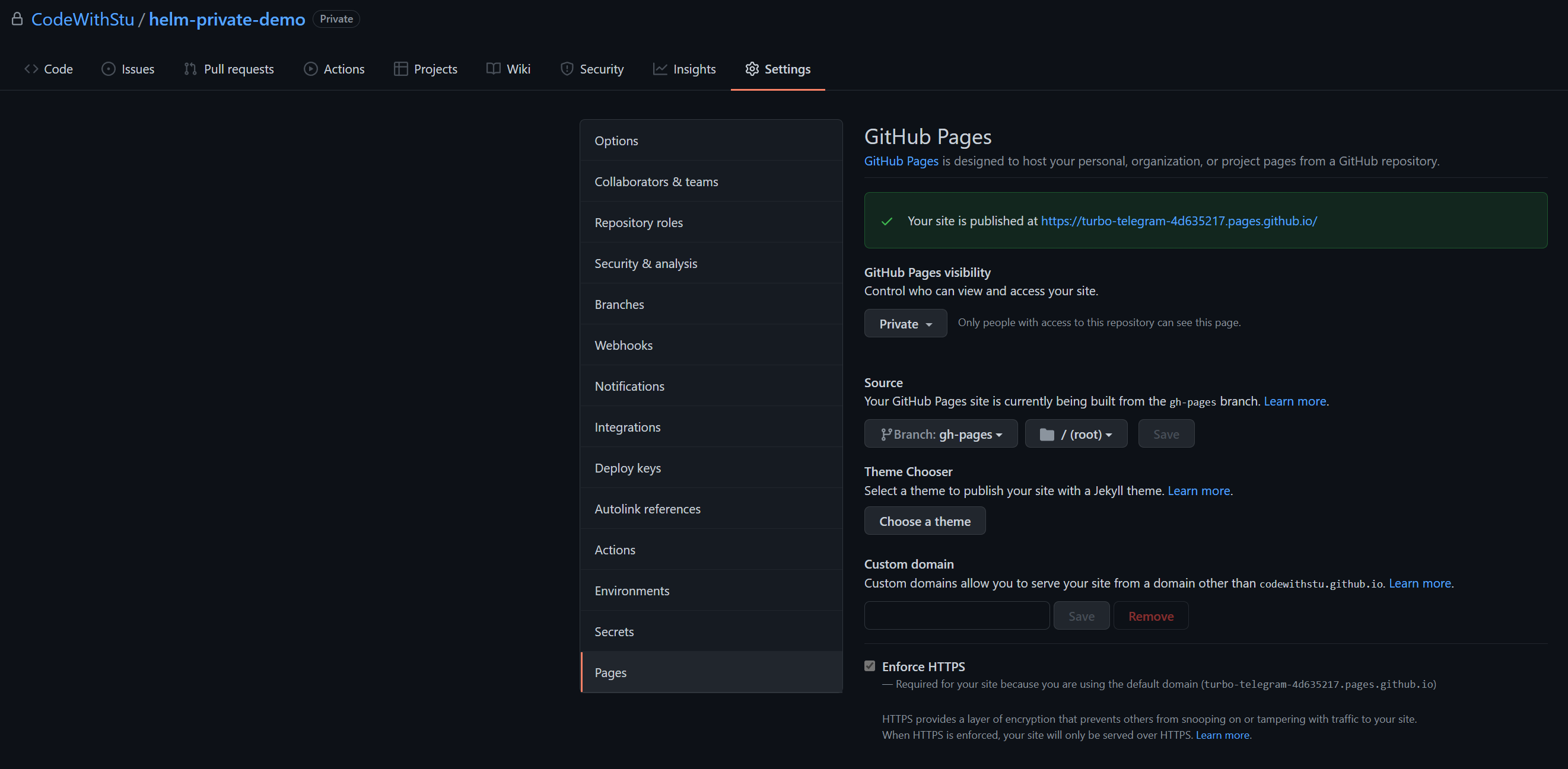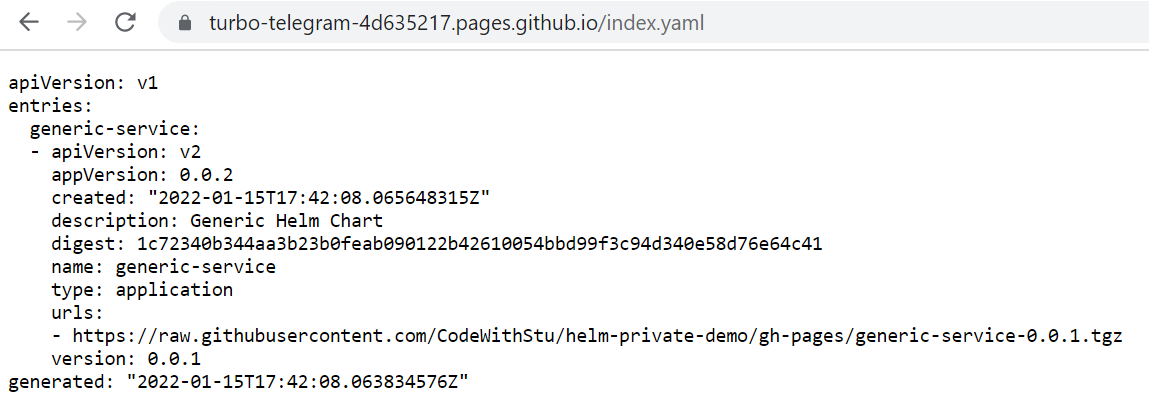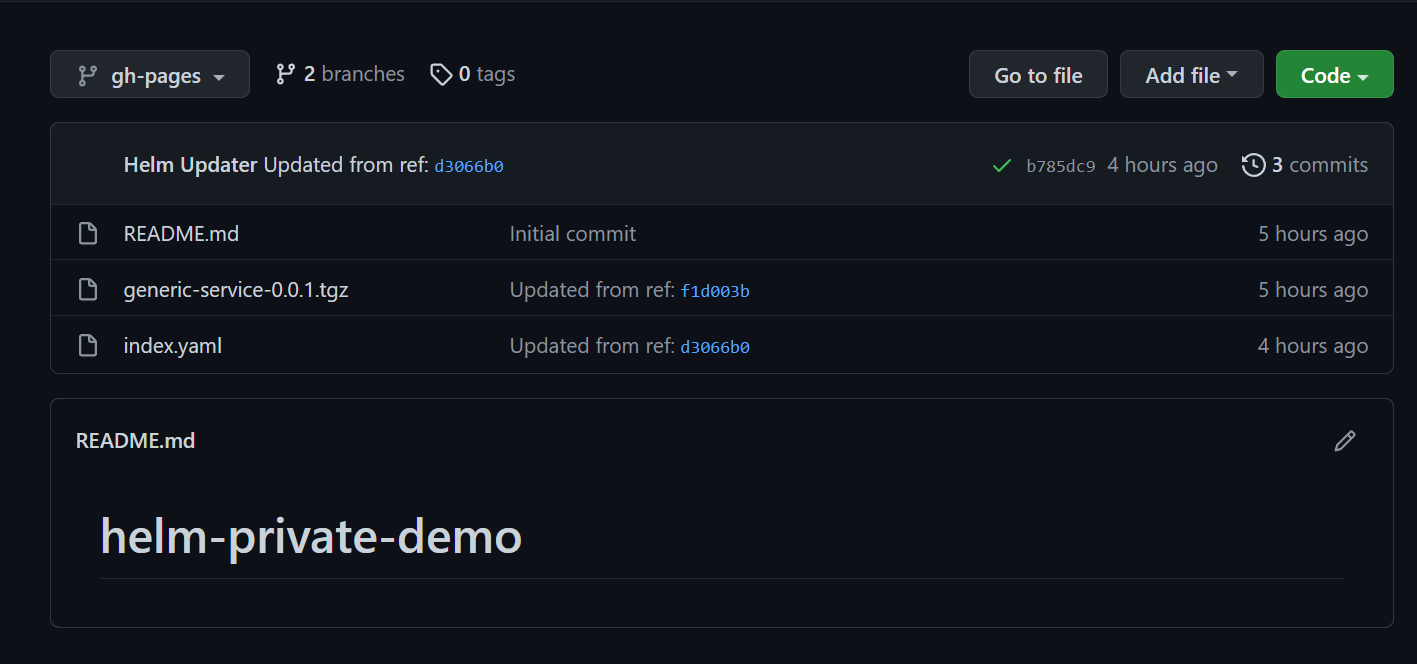In this article, we’re going to take a look at how to create a private Helm repository with Github Pages. This guide requires you to have a Github Enterprise license as private Github Pages are only available to enterprise customers. I’m showing this approach for the scenarios where setting up something like ChartMuseum isn’t possible or unwanted. Although this guide uses helm as the example, you can extend this to host anything under a privately authenticated Github page.
Prerequisites
For this approach to work, you need to have the following in place:
- A private Github repository as part of a Github Enterprise
- 2 branches setup in the repository:
- main - This is where your chart source lives
- gh-pages - This is where the charts are published
- A personal access token (PAT) that can access the repository
Setup Github Pages
Once you have the prerequisites in place, you will need to setup your Github Pages with the following settings:

The key parts of the setup are:
- Ensure that the repository pages are set to private
- The branch is set to
gh-pagesat the root
Please note that your URL that Github generates for you will be different and you do not actually need this URL for the rest of the tutorial.
Publish Action
Helm relies on an index file that tells us the location of all the charts for a given repository and provides their download links. To build our index, we need to update it as soon as we push to the main branch. Let’s take a look at the following Github Action:
name: Release Helm Charts
# Do not change this
concurrency: release-helm
on:
workflow_dispatch:
push:
branches:
- main
jobs:
release:
runs-on: ubuntu-latest
steps:
- name: Checkout
uses: actions/checkout@v2
with:
path: 'src'
fetch-depth: 0
- name: Checkout
uses: actions/checkout@v2
with:
path: 'dest'
ref: 'gh-pages'
fetch-depth: 0
- name: Install Helm
uses: azure/setup-helm@v1
- name: Package Helm Charts
shell: bash
run: |
find src/charts/ -type f -name 'Chart.yaml' | sed -r 's|/[^/]+$||' | sort | uniq | xargs -L 1 helm dep up
for d in src/charts/*/ ; do
echo "$d"
helm package "$d" -u -d dest
done
- name: Push New Files
shell: bash
working-directory: dest
run: |
helm repo index . --url https://raw.githubusercontent.com/CodeWithStu/helm-private-demo/gh-pages/
git config user.name "Helm Updater"
git config user.email "[email protected]"
git add $(git ls-files -o --exclude-standard)
git add index.yaml
git commit -m "Updated from ref: $GITHUB_SHA"
git push
Starting from the top, we have concurrency: release-helm. This tells Github that only a single instance of this action should be run as once, this is because later on we will be publishing the action to a different branch and git will get confused if we tried to do this in parallel. Next, we checkout two different branches, one for main and one for gh-pages:
- name: Checkout
uses: actions/checkout@v2
with:
path: 'src'
fetch-depth: 0
- name: Checkout
uses: actions/checkout@v2
with:
path: 'dest'
ref: 'gh-pages'
fetch-depth: 0
This is so that we can easily use standard git commands to push files to a branch. The next interesting part is where we package the helm charts:
- name: Package Helm Charts
shell: bash
run: |
find src/charts/ -type f -name 'Chart.yaml' | sed -r 's|/[^/]+$||' | sort | uniq | xargs -L 1 helm dep up
for d in src/charts/*/ ; do
echo "$d"
helm package "$d" -u -d dest
done
Here we look in the charts directory of src, which is where we cloned our main branch in to, and run helm dep up on each of the charts that we find, including subcharts. This ensures that we have everything that we need to package the chart.
When packaging the chart, we put it in the dest folder which is the folder we cloned our gh-pages branch to. This contains all of the charts from the main branch packaged alongside the helm index file.
In order to commit all of this back to git we use the following set of commands:
- name: Push New Files
shell: bash
working-directory: dest
run: |
helm repo index . --url https://raw.githubusercontent.com/CodeWithStu/helm-private-demo/gh-pages/
git config user.name "Helm Updater"
git config user.email "[email protected]"
git add $(git ls-files -o --exclude-standard)
git add index.yaml
git commit -m "Updated from ref: $GITHUB_SHA"
git push
helm repo index creates the new index file, or updates it when it already exists, based on the contents of the gh-pages branch. Note the URL that’s specified, which means that all content comes from here. Without this, helm will not work. It also must be a raw.githubusercontent.com address not the randomly generated URL from the pages settings. This is because this endpoint supports the basic authentication required for the private feed.
git add $(git ls-files -o --exclude-standard) basically tells git to add any files that it thinks have been changed/added, before we run standard git commands to commit and push. To push, we do need to specify the name/email of the user that’s committing, though this can be anything that you want.
Once the action has published, you should be able to access the generated helm index in your browser (you may need to authenticate with your normal github login or with your PAT token):

And you’ll see this in your repository on the gh-pages branch:

Using with Helm
To use the generated index with helm, you need to supply the https://raw.githubusercontent.com address we used earlier to helm, along with your username and generated PAT token:
helm repo add private https://raw.githubusercontent.com/CodeWithStu/helm-private-demo/gh-pages/ --username <Your Username> --password <Your PAT token>
helm repo update
This will use Github basic authentication to pull the index and allow you to search and use the repository. The result will look something similar to the following:
> helm search repo private
NAME CHART VERSION APP VERSION DESCRIPTION
private/generic-service 0.0.1 0.0.2 Generic Helm Chart
From here you are free to use your new helm repository as if it was any other helm repository. Enjoy!